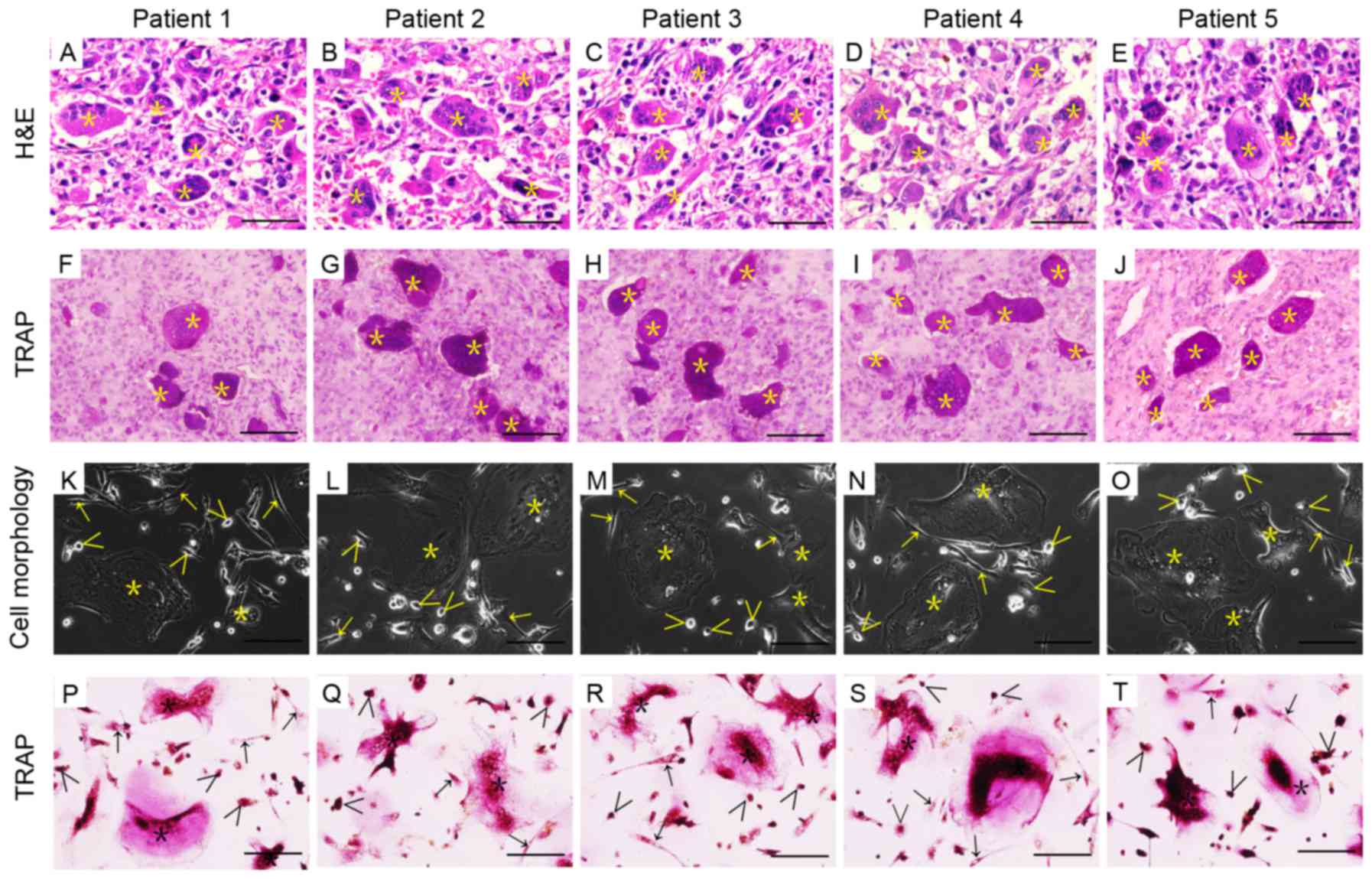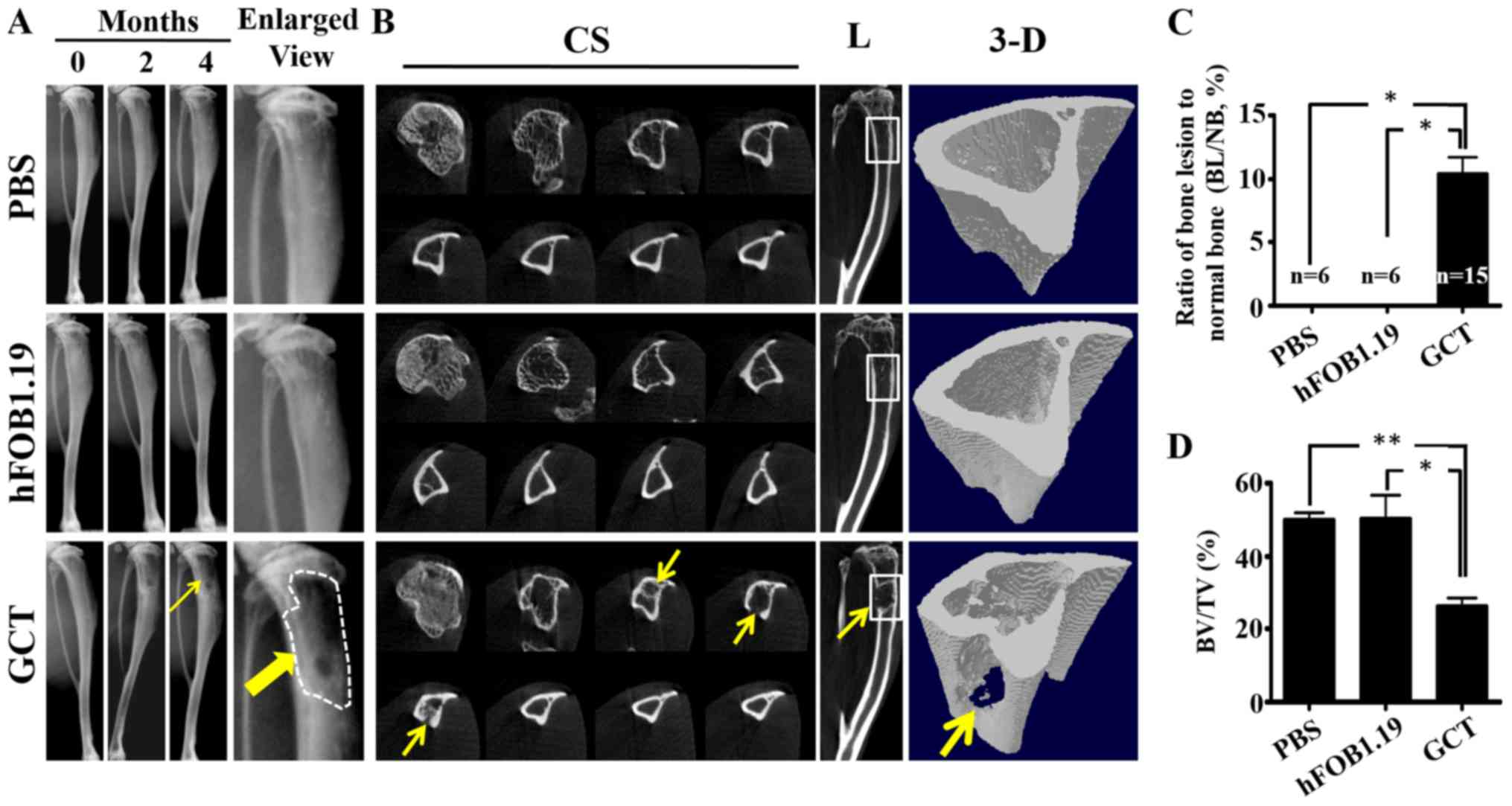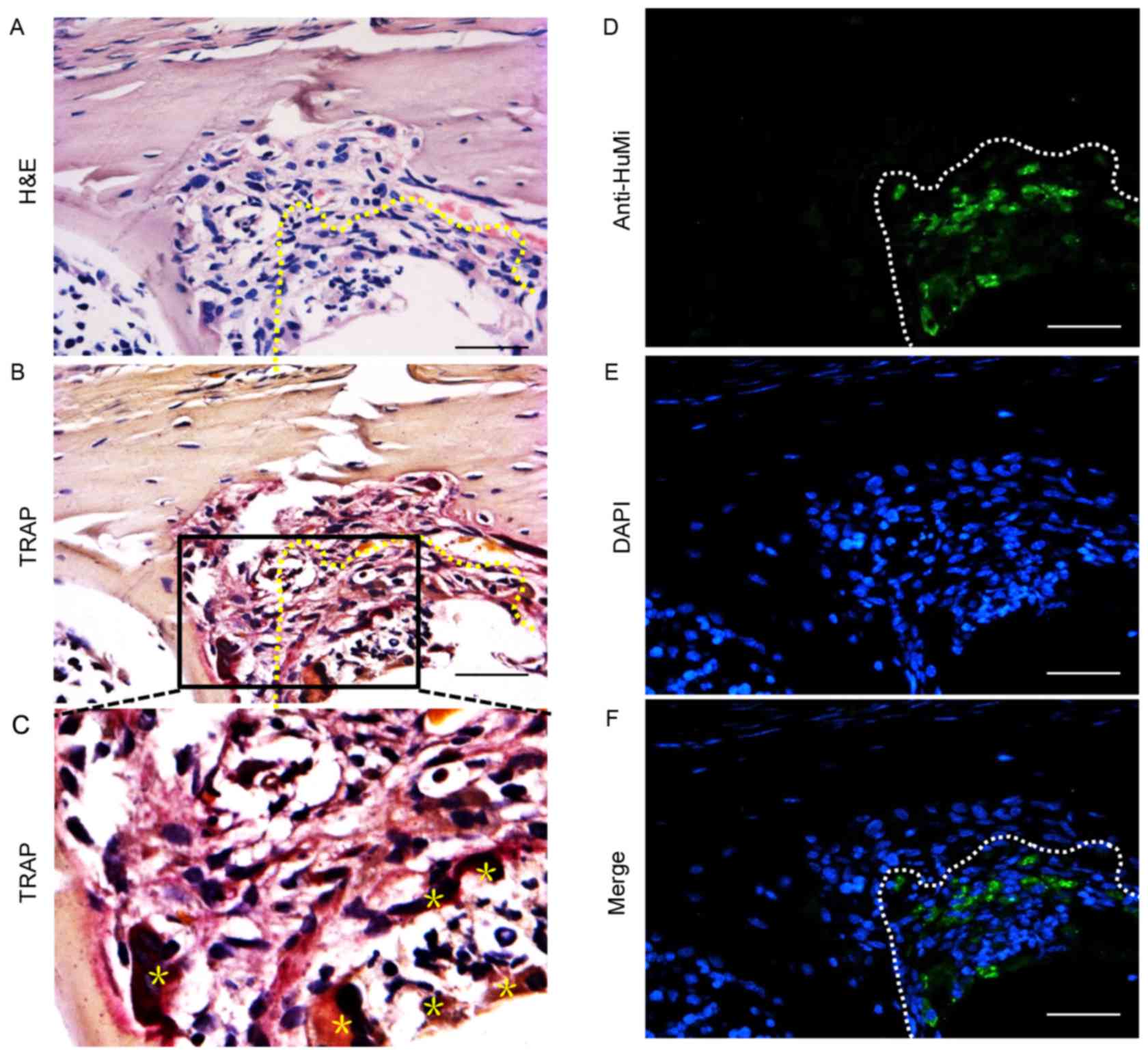|
1
|
Cowan RW and Singh G: Giant cell tumor of
bone: A basic science perspective. Bone. 52:238–246. 2013.
View Article : Google Scholar : PubMed/NCBI
|
|
2
|
Alsulaimani SA and Turcotte RE; Canadian
Orthopaedic Oncology Society (CANOOS) collaborators, : Iterative
curettage is associated with local control in giant cell tumors
involving the distal tibia. Clin Orthop Relat Res. 471:2668–2674.
2013. View Article : Google Scholar : PubMed/NCBI
|
|
3
|
Stacy GS, Peabody TD and Dixon LB: Mimics
on radiography of giant cell tumor of bone. AJR Am J Roentgenol.
181:1583–1589. 2003. View Article : Google Scholar : PubMed/NCBI
|
|
4
|
Prosser GH, Baloch KG, Tillman RM, Carter
SR and Grimer RJ: Does curettage without adjuvant therapy provide
low recurrence rates in giant-cell tumors of bone? Clin Orthop
Relat Res. 435:211–218. 2005. View Article : Google Scholar
|
|
5
|
Kremen TJ Jr, Bernthal NM, Eckardt MA and
Eckardt JJ: Giant cell tumor of bone: Are we stratifying results
appropriately? Clin Orthop Relat Res. 470:677–683. 2012. View Article : Google Scholar : PubMed/NCBI
|
|
6
|
Lin WH, Lan TY, Chen CY, Wu K and Yang RS:
Similar local control between phenol- and ethanol-treated giant
cell tumors of bone. Clin Orthop Relat Res. 469:3200–3208. 2011.
View Article : Google Scholar : PubMed/NCBI
|
|
7
|
Klenke FM, Wenger DE, Inwards CY, Rose PS
and Sim FH: Recurrent giant cell tumor of long bones: Analysis of
surgical management. Clin Orthop Relat Res. 469:1181–1187. 2011.
View Article : Google Scholar : PubMed/NCBI
|
|
8
|
Klenke FM, Wenger DE, Inwards CY, Rose PS
and Sim FH: Giant cell tumor of bone: Risk factors for recurrence.
Clin Orthop Relat Res. 469:591–599. 2011. View Article : Google Scholar : PubMed/NCBI
|
|
9
|
Goldring SR, Schiller AL, Mankin HJ, Dayer
JM and Krane SM: Characterization of cells from human giant cell
tumors of bone. Clin Orthop Relat Res. 1–75. 1986.
|
|
10
|
Komiya S, Sasaguri Y, Inoue A, Nakashima
M, Yamamoto S, Yanagida I and Morimatsu M: Characterization of
cells cultured from human giant-cell tumors of bone. Phenotypic
relationship to the monocyte-macrophage and osteoclast. Clin Orthop
Relat Res. 258:304–309. 1990.
|
|
11
|
Salerno M, Avnet S, Alberghini M, Giunti A
and Baldini N: Histogenetic characterization of giant cell tumor of
bone. Clin Orthop Relat Res. 466:2081–2091. 2008. View Article : Google Scholar : PubMed/NCBI
|
|
12
|
Wülling M, Delling G and Kaiser E: The
origin of the neoplastic stromal cell in giant cell tumor of bone.
Hum Pathol. 34:983–993. 2003. View Article : Google Scholar : PubMed/NCBI
|
|
13
|
Lau CP, Ng PK, Li MS, Tsui SK, Huang L and
Kumta SM: p63 regulates cell proliferation and cell cycle
progressionassociated genes in stromal cells of giant cell tumor of
the bone. Int J Oncol. 42:437–443. 2013. View Article : Google Scholar : PubMed/NCBI
|
|
14
|
Wuelling M, Delling G and Kaiser E:
Differential gene expression in stromal cells of human giant cell
tumor of bone. Virchows Arch. 445:621–630. 2004. View Article : Google Scholar : PubMed/NCBI
|
|
15
|
Babeto E, Conceição AL, Valsechi MC, Peitl
Junior P, de Campos Zuccari DA, de Lima LG, Bonilha JL, de Freitas
Calmon M, Cordeiro JA and Rahal P: Differentially expressed genes
in giant cell tumor of bone. Virchows Arch. 458:467–476. 2011.
View Article : Google Scholar : PubMed/NCBI
|
|
16
|
Chen S, Li C, Wu B, Zhang C, Liu C, Lin X,
Wu X, Sun L, Liu C, Chen B, et al: Identification of differentially
expressed genes and their subpathways in recurrent versus primary
bone giant cell tumors. Int J Oncol. 45:1133–1142. 2014. View Article : Google Scholar : PubMed/NCBI
|
|
17
|
Fujikawa Y, Quinn JM, Sabokbar A, McGee JO
and Athanasou NA: The human osteoclast precursor circulates in the
monocyte fraction. Endocrinology. 137:4058–4060. 1996. View Article : Google Scholar : PubMed/NCBI
|
|
18
|
Massey HM and Flanagan AM: Human
osteoclasts derive from CD14-positive monocytes. Br J Haematol.
106:167–170. 1999. View Article : Google Scholar : PubMed/NCBI
|
|
19
|
Lau YS, Sabokbar A, Gibbons CL, Giele H
and Athanasou N: Phenotypic and molecular studies of giant-cell
tumors of bone and soft tissue. Hum Pathol. 36:945–954. 2005.
View Article : Google Scholar : PubMed/NCBI
|
|
20
|
Haque AU and Moatasim A: Giant cell tumor
of bone: A neoplasm or a reactive condition? Int J Clin Exp Pathol.
1:489–501. 2008.PubMed/NCBI
|
|
21
|
Werner M: Giant cell tumour of bone:
Morphological, biological and histogenetical aspects. Int Orthop.
30:484–489. 2006. View Article : Google Scholar : PubMed/NCBI
|
|
22
|
James IE, Dodds RA, Olivera DL, Nuttall ME
and Gowen M: Human osteoclastoma-derived stromal cells: Correlation
of the ability to form mineralized nodules in vitro with formation
of bone in vivo. J Bone Miner Res. 11:1453–1460. 1996. View Article : Google Scholar : PubMed/NCBI
|
|
23
|
Balke M, Neumann A, Szuhai K, Agelopoulos
K, August C, Gosheger G, Hogendoorn PC, Athanasou N, Buerger H and
Hagedorn M: A short-term in vivo model for giant cell tumor of
bone. BMC Cancer. 11:2412011. View Article : Google Scholar : PubMed/NCBI
|
|
24
|
Singh S, Singh M, Mak I and Ghert M:
Expressional analysis of GFP-tagged cells in an in vivo mouse model
of giant cell tumor of bone. Open Orthop J. 7:109–113. 2013.
View Article : Google Scholar : PubMed/NCBI
|
|
25
|
Oreffo RO, Marshall GJ, Kirchen M, Garcia
C, Gallwitz WE, Chavez J, Mundy GR and Bonewald LF:
Characterization of a cell line derived from a human giant cell
tumor that stimulates osteoclastic bone resorption. Clin Orthop
Relat Res. 229–241. 1993.PubMed/NCBI
|
|
26
|
Long F, Cai X, Luo W, Chen L and Li K:
Role of aldolase A in osteosarcoma progression and metastasis: In
vitro and in vivo evidence. Oncol Rep. 32:2031–2037. 2014.
View Article : Google Scholar : PubMed/NCBI
|
|
27
|
Park SI, Kim SJ, McCauley LK and Gallick
GE: Pre-clinical mouse models of human prostate cancer and their
utility in drug discovery. Curr Protoc Pharmacol Chapter. 14:Unit
14.15. 2010. View Article : Google Scholar
|
|
28
|
Hoff BA, Chughtai K, Jeon YH, Kozloff K,
Galbán S, Rehemtulla A, Ross BD and Galbán CJ: Multimodality
imaging of tumor and bone response in a mouse model of bony
metastasis. Transl Oncol. 5:415–421. 2012. View Article : Google Scholar : PubMed/NCBI
|
|
29
|
Futakuchi M and Singh RK: Animal model for
mammary tumor growth in the bone microenvironment. Breast Cancer
(Tokyo, Japan). 20:195–203. 2013. View Article : Google Scholar : PubMed/NCBI
|
|
30
|
Balla P, Moskovszky L, Sapi Z, Forsyth R,
Knowles H, Athanasou NA, Szendroi M, Kopper L, Rajnai H, Pinter F,
et al: Epidermal growth factor receptor signalling contributes to
osteoblastic stromal cell proliferation, osteoclastogenesis and
disease progression in giant cell tumour of bone. Histopathology.
59:376–389. 2011. View Article : Google Scholar : PubMed/NCBI
|
|
31
|
National Research Council (US) Committee
for the Update of the Guide for the Care and Use of Laboratory
Animals: Guide for the Care and Use of Laboratory Animals. 8th
edition. National Academies Press; Washington, DC: 2011
|
|
32
|
Tang X, Jin R, Qu G, Wang X, Li Z, Yuan Z,
Zhao C, Siwko S, Shi T, Wang P, et al: GPR116, an adhesion
G-protein-coupled receptor, promotes breast cancer metastasis via
the Gαq-p63RhoGEF-Rho GTPase pathway. Cancer Res. 73:6206–6218.
2013. View Article : Google Scholar : PubMed/NCBI
|
|
33
|
Huang L, Teng XY, Cheng YY, Lee KM and
Kumta SM: Expression of preosteoblast markers and Cbfa-1 and
Osterix gene transcripts in stromal tumour cells of giant cell
tumour of bone. Bone. 34:393–401. 2004. View Article : Google Scholar : PubMed/NCBI
|
|
34
|
Murata A, Fujita T, Kawahara N, Tsuchiya H
and Tomita K: Osteoblast lineage properties in giant cell tumors of
bone. J Orthop Sci. 10:581–588. 2005. View Article : Google Scholar : PubMed/NCBI
|
|
35
|
Ghert M, Simunovic N, Cowan RW, Colterjohn
N and Singh G: Properties of the stromal cell in giant cell tumor
of bone. Clin Orthop Relat Res. 459:8–13. 2007. View Article : Google Scholar : PubMed/NCBI
|
|
36
|
Yang T, Zheng XF, Li M, Lin X and Yin QS:
Stimulation of osteogenic differentiation in stromal cells of giant
cell tumour of bone by zoledronic acid. Asian Pac J Cancer Prev.
14:5379–5383. 2013. View Article : Google Scholar : PubMed/NCBI
|
|
37
|
McQuibban GA, Butler GS, Gong JH, Bendall
L, Power C, Clark-Lewis I and Overall CM: Matrix metalloproteinase
activity inactivates the CXC chemokine stromal cell-derived
factor-1. J Biol Chem. 276:43503–43508. 2001. View Article : Google Scholar : PubMed/NCBI
|
|
38
|
Atkins GJ, Haynes DR, Graves SE, Evdokiou
A, Hay S, Bouralexis S and Findlay DM: Expression of osteoclast
differentiation signals by stromal elements of giant cell tumors. J
Bone Miner Res. 15:640–649. 2000. View Article : Google Scholar : PubMed/NCBI
|
|
39
|
McQuibban GA, Gong JH, Wong JP, Wallace
JL, Clark-Lewis I and Overall CM: Matrix metalloproteinase
processing of monocyte chemoattractant proteins generates CC
chemokine receptor antagonists with anti-inflammatory properties in
vivo. Blood. 100:1160–1167. 2002.PubMed/NCBI
|
|
40
|
Ohsaki Y, Takahashi S, Scarcez T, Demulder
A, Nishihara T, Williams R and Roodman GD: Evidence for an
autocrine/paracrine role for interleukin-6 in bone resorption by
giant cells from giant cell tumors of bone. Endocrinology.
131:2229–2234. 1992. View Article : Google Scholar : PubMed/NCBI
|
|
41
|
Sasaguri Y, Komiya S, Sugama K, Suzuki K,
Inoue A, Morimatsu M and Nagase H: Production of matrix
metalloproteinases 2 and 3 (stromelysin) by stromal cells of giant
cell tumor of bone. Am J Pathol. 141:611–621. 1992.PubMed/NCBI
|
|
42
|
Ueda Y, Imai K, Tsuchiya H, Fujimoto N,
Nakanishi I, Katsuda S, Seiki M and Okada Y: Matrix
metalloproteinase 9 (gelatinase B) is expressed in multinucleated
giant cells of human giant cell tumor of bone and is associated
with vascular invasion. Am J Pathol. 148:611–622. 1996.PubMed/NCBI
|
|
43
|
Cowan RW, Singh G and Ghert M: PTHrP
increases RANKL expression by stromal cells from giant cell tumor
of bone. J Orthop Res. 30:877–884. 2012. View Article : Google Scholar : PubMed/NCBI
|
|
44
|
Morgan T, Atkins GJ, Trivett MK, Johnson
SA, Kansara M, Schlicht SL, Slavin JL, Simmons P, Dickinson I,
Powell G, et al: Molecular profiling of giant cell tumor of bone
and the osteoclastic localization of ligand for receptor activator
of nuclear factor kappaB. Am J Pathol. 167:117–128. 2005.
View Article : Google Scholar : PubMed/NCBI
|












